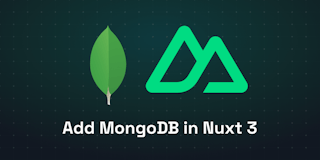Integrating MongoDB and Mongoose with Nuxt 3

Building dynamic web applications often requires seamless integration with a robust database solution. When it comes to creating powerful server-side applications, MongoDB has emerged as a popular choice among developers due to its flexibility and scalability. Combined with the Vue.js framework, Nuxt.js provides a solid foundation for building fast, server-rendered applications. However, incorporating MongoDB and its object modeling tool, Mongoose, into a Nuxt project might seem like a daunting task for those new to the stack.
In this blog post, we'll explore two simple yet effective methods to add MongoDB and Mongoose to your Nuxt 3 project. Whether you're a seasoned developer or just starting your journey in full-stack web development, this guide will help you leverage the capabilities of MongoDB and Mongoose within the Nuxt ecosystem.
Prerequisites
Before we get started, make sure you have a working nuxt 3 project. If you don't have one already, you can create a new project using the following command:
npx nuxi init <project-name>
Once the project is created, navigate to the project directory and install the dependencies:
cd <project-name>
npm install // or yarn install
Now that we have a working nuxt 3 project, let's explore the two methods of adding MongoDB and Mongoose to our project.
Method 1: Using the nuxt-server-utils module
This is the easiest way to add MongoDB and Mongoose to your Nuxt 3 project. The nuxt-server-utils module provides a set of utilities that allow you to interact with your MongoDB database from within your Nuxt 3 application. It also provides a simple API for creating and managing your MongoDB collections.
To get started, install the nuxt-server-utils module using the following command:
npm install nuxt-server-utils mongoose
Next, Add the nuxt-server-utils module to the modules section of your nuxt.config.ts file:
Add nuxt-server-utils to the modules section of nuxt.config.ts:
export default defineNuxtConfig({
// ...
modules: ["nuxt-server-utils"],
});
Finally, add the MongoDB connection string to the .env file of your nuxt app:
MONGODB_URI=<your-mongodb-connection-string>
That's it! Now you can use mongoose in your Nuxt 3 server routes like how it is normally used in Express. For example, let's create a simple server route that returns all the documents from a MongoDB collection:
Defining the Mongoose model in server/models/user.model.ts:
import { Schema, model } from "mongoose";
const UserSchema = new Schema({
name: String,
email: String,
});
export const User = model("User", UserSchema);
Now let's create the API Route in server/api/users.get.ts:
import { User } from "~~/server/models/user.model";
export default defineEventHandler(async (event) => {
const users = await User.find();
return Users;
});
If you navigate to the /api/users route, you should see a list of all the users in your database.
Video Tutorial
If you enjoy learning through video tutorials, I have created a video where i walk you through the above steps:
Example Project
Method 2: Creating a Nitro plugin
Nuxt 3 uses Nitro under the hood to power its server-side rendering capabilities. Nitro provides a simple API for creating plugins that can be used to extend the functionality of your Nuxt 3 application. In this section, we'll create a Nitro plugin that will allow us to use MongoDB and Mongoose in our Nuxt 3 project.
First, let's create a new plugin file in the server/plugins directory:
touch server/plugins/mongodb.ts
Then let's install the required dependencies:
npm install mongoose
Next, let's add the following code to the newly created plugin file:
import { Nitro } from "nitropack";
import mongoose from "mongoose";
export default async (_nitroApp: Nitro) => {
const config = useRuntimeConfig();
try {
await mongoose.connect(config.mongodbUri);
console.log("Connected to MongoDB");
} catch (e) {
console.error(e);
}
};
Finally, let's add the plugin to the plugins section of our nuxt.config.ts file:
export default defineNuxtConfig({
// ...
nitro: {
plugins: ["~/server/plugins/mongodb.ts"],
},
});
That's it! Now you can use mongoose in your Nuxt 3 server routes like how it is normally used in Express.
Video Tutorial
If you prefer video tutorials, you can watch the following video where I walk you through the process of adding MongoDB and Mongoose to a Nuxt 3 project:
Example Project
Play around with the example project to get a better understanding of how to use MongoDB and Mongoose with Nuxt 3.
You ca find the full source code of this example here.
Conclusion
In this blog post, we explored two simple yet effective methods to add MongoDB and Mongoose to your Nuxt 3 project. Whether you're a seasoned developer or just starting your journey in full-stack web development, this guide will help you leverage the capabilities of MongoDB and Mongoose within the Nuxt ecosystem.
If you have any questions or feedback, feel free to reach out to me on Discord or Twitter.